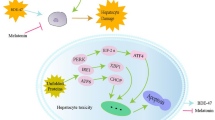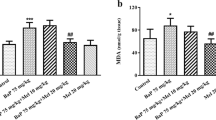Abstract
Naphthalene is a bicyclic aromatic compound that is widely used in various domestic and commercial applications. Previous studies in our laboratory have demonstrated enhanced production of reactive oxygen species, lipid peroxidation and DNA fragmentation in both in vitro and in vivo models following treatment with naphthalene. Melatonin (N‐acetyl‐5‐methoxytryptamine), an indole hormone, is the chief secretory product of the pineal gland and is an efficient free radical scavenger and antioxidant, both in vitro and in vivo. In this study, we have investigated the ability of 1 mM melatonin to protect against naphthalene-induced oxidative stress and DNA damage in cultured macrophage J774A.1 cells. No significant changes were observed when these macrophage cells were treated with 100 μM naphthalene. Approximately 2.0‐, 4.2‐ and 4.4‐fold increases in cytochrome c reduction were observed at 200, 400 and 500 mM concentrations of naphthalene, demonstrating the increased production of superoxide anion. At 24 h, lipid peroxidation increased by approximately 1.4‐, 2.1‐ and 2.2‐fold following treatment of these cells with 200, 400 and 500 mM concentrations of naphthalene, respectively, while 1.6‐, 2.8‐ and 2.8‐fold increases in DNA fragmentation were observed at these same concentrations. Two hour pretreatment of these cultured cells with 1 mM melatonin provided approximately 26–44% decreases in lipid peroxidation, superoxide anion production and DNA fragmentation in cells treated with 400 and 500 μM naphthalene. Cellular viability decreased significantly when cells were incubated with concentrations of naphthalene greater than 100 μM, while preincubation with melatonin significantly increased the cellular viability. These results demonstrate that naphthalene may induce toxic manifestations by enhanced production of reactive oxygen free radicals, resulting in lipid peroxidation and DNA damage, while preincubation with melatonin significantly suppressed cytoxicity in J774A.1 macrophage cells.
Similar content being viewed by others
References
Bagchi M, Bagchi D, Balmoori J, Ye X, Stohs SJ: Naphthalene-induced oxidative stress and DNA damage in cultured macrophage J774A.1 cells. Free Rad Biol Med 25: 137–143, 1998
Buonarati M, Jones AD, Buckpitt AR: In vivo metabolism of isomeric naphthalene oxide glutathione conjugates. Dispos 18: 183–189, 1990
Cho M, Jedrychowski R, Hammock B, Buckpitt A: Reactive naphthalene metabolite binding to hemoglobin and albumin. Fund Appl Toxicol 22: 26–33, 1994
Miller M, Powell J, Cohen G: Formation and identification of naphthoquinone conjugates following microsomal metabolism of 1-naphthol. In: Biological Reactive Intermediates. Plenum, New York, 1986, pp 391–398
Vuchetich PJ, Bagchi D, Bagchi M, Hassoun EA, Tang L, Stohs SJ: Naphthalene-induced oxidative stress in rats and the protective effects of vitamin E succinate. Free Rad Biol Med 21: 577–590, 1996
Bagchi D, Hassoun EA, Bagchi M, Stohs SJ: Protective effects of free radical scavengers and antioxidants against smokeless tobacco extract (STE)-induced oxidative stress in macrophage J774A.1 cell cultures. Arch Environ Contam Toxicol 29: 424–428, 1995
Koch HR, Doldi K, Hockwin O: Naphthalene cataract development. Doc Opthal 3: 323–332, 1976
Lubek BM, Kubow S, Basu PK, Wells PG: Cataractogenicity and bioactivation of naphthalene derivatives in lens culture and in vivo. Lens Eye Toxicol Res 6: 203–209, 1989
Reiter RJ, Tan D, Kim SJ, Manchester LC, Qi W, Garcia JJ, Cabera JC, El-Sokkary G, Rouvier-Garay V: Augmentation of indices of oxidative damage in life long melatonin-deficient rats. Mech Aging Dev 110: 157–173, 1999
Reiter RJ, Tan DX, Cabera J, D-Arpa D, Sainz RM, Mayo JC, Ramor S: The oxidant/antioxidant network: Role of melatonin. Biol Signals Recept 8: 56–63, 1999
Reiter RJ, Carneiro RC, Oh CS: Melatonin in relation to cellular antioxidative defense mechanisms. Horm Metal Res 8: 363–372, 1997
Ralph P, Nakoinz I: Antibody-dependent killing of erythrocyte and tumor targets by macrophage related cell lines: enhancement by PPD and LPS. J Immunol 119: 950–954, 1977
Hsu CH, Han BC, Liu MY, Yeh CY, Casida JE: Phosphine-induced oxidative damage in rats: Attenuation by melatonin. Free Rad Biol Med 28: 636–642, 2000
Beuge JA, Aust SD: Microsomal lipid peroxidation. Meth Enzymol 52: 302–310, 1978
Largilliere C, Melancon SB: Free malondialdehyde determination inhuman plasma by high performance liquid chromatography. Anal Biochem 170: 126–126, 1988
Babior BM, Kipnes RS, Curnette JT: The production by leukocytes of superoxide: A potential bactericidal agent. J Clin Invest 52: 741–744, 1973
Bagchi M, Stohs SJ: In vitro induction of reactive oxygen species by 2,3,7,8-tetrachlorodibenzo-p-dioxin, endrin, and lindane in rat peritoneal macrophages, and hepatic mitochondria and microsomes. Free Rad Biol Med 14: 11–18, 1993
Bagchi M, Balmoori J, Bagchi, D, Ray SD, Kuszynski C, Stohs SJ: Smokeless tobacco, oxidative stress, apoptosis, and antioxidants in human oral keratinocytes. Free Rad Biol Med 26: 992–100, 1999
Tan D-X, Manchester LC, Reiter RJ, Plummer BF, Limson J, Weintraub ST, Wenbo Q: Melatonin directly scavenges hydrogen peroxide: A potentially new metabolic pathway of melatonin biotransformation. Free Rad Biol Med 29: 1177–1185, 2000
Blask DE, Sauer LA, Dauchy RT, Holwachuk EW, Ruhoff MS, Kopff HS: Melatonin inhibition of cancer growth in vivo involves suppression of tumor fatty acid metabolism via melatonin receptor-mediated signal transduction events. Cancer Res 59: 4693–4701, 1999
Romero MP, Osuna C, Garcia-Perganeda A, Carrillo-Vico A, Guerrero JM: The pineal secretory product melatonin reduces hydrogen peroxide induced DNA damage in U-937 cells. J Pineal Res 26: 227–235, 1999
Zhang H, Squadrito GL, Uppu R, Pryor WA: Reaction of peroxynitrite with melatonin: A mechanistic study. Chem Res Toxicol 6: 526–534, 1999
Zang LY, Cosma G, Garner H, Vallynathan V: Scavenging reactive oxygen species by melatonin. Biochim Biophys Acta 1425: 469–477, 1998
Lissoni P, Rovelli F, Meregalli S, Fumagalli L, Musco F, Brivio F, Brivio O: Melatonin as a new possible anti-inflammatory agent. J Biol Regul Homeost Agents 11: 157–159, 1997
Suhner A, Schlagenhauf P, Johnson R, Tschopp A, Steffen R: Comparative study to determine the optimal melatonin dosage form for the alleviation of jet lag. Chronobiol Int 15: 655–666, 1998
Vijayalaxmi, Meltz ML, Reiter RJ, Herman TS, Kumar KS: Melatonin and protection from whole-body irradiation: Survival study in mice. Mutat Res 425: 21–27, 1999
Daniels WM, Reiter RJ, Melchiorri D, Sewerynek E, Pablos MI, Ortiz GG: Melatonin counteracts lipid peroxidation induced by carbon tetrachloride but does not restore glucose-6-phosphate activity. J Pineal Res 19: 1–6, 1995
Miller M, Powell J, Cohen G: Formation and identification of naphthoquinone glutathione conjugates following microsomal metabolism of 1-naphthol. In: J. Kocsis, D. Jollow, C. Witmer, J. Nelson, R. Snyder (eds). Biologically Reactive Intermediates, vol. III. Plenum Press, New York, 1986, pp 391–398
Henry TR, Wallace KB: Differential mechanisms of cell killing by redox cycling and arylating quinones. Arch Toxicol 70: 482–489, 1996
Qi W, Reiter RJ, Tan DX, Manchester LC, Garcia JJ: Inhibitory effects of melatonin on ferric nitriloacetate-induced lipid peroxidation and oxidative DNA damage in the rat kidney. Toxicology 139: 81–91, 1999
Kaya H, Delibas N, Serteser M, Ulukaya E, Ozkaya O: The effect of melatonin on lipid peroxidation during radiotherapy in female rats. Strahlenther Onkol 175: 285–288, 1999
Garcia-Maurino S, Pozo D, Carrilo-Vico A, Calvo JR, Guerrero JM: Melatonin activates Th 1 lymphocytes by increasing IL-12 production. Life Sci 20: 2143–2150, 1999
Urata Y, Honma S, Goto S, Todoroki S, Irida T, Cho S, Honma K, Kondo T: Melatonin induces gamma-glutamyl cysteine synthetase mediated by activator protein-1 in human vascular endothelial cells. Free Rad Biol Med 27: 838–847, 1999
Susa N, Ueno S, Furukawa Y, Ueda J, Sugiyama N: Potent protective effect of melatonin on chromium (VI)-induced DNA single strand breaks, cytotoxicity and lipid peroxidation in primary culture of rat hepatocytes. Toxicol Appl Pharmacol 144: 377–384, 1997
Author information
Authors and Affiliations
Rights and permissions
About this article
Cite this article
Bagchi, M., Balmoori, J., Ye, X. et al. Protective effect of melatonin on naphthalene‐induced oxidative stress and DNA damage in cultured macrophage J774A.1 cells. Mol Cell Biochem 221, 49–55 (2001). https://doi.org/10.1023/A:1010946517651
Published:
Issue Date:
DOI: https://doi.org/10.1023/A:1010946517651




